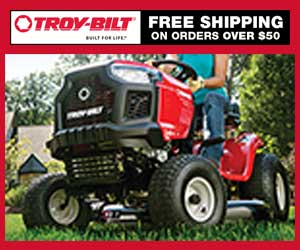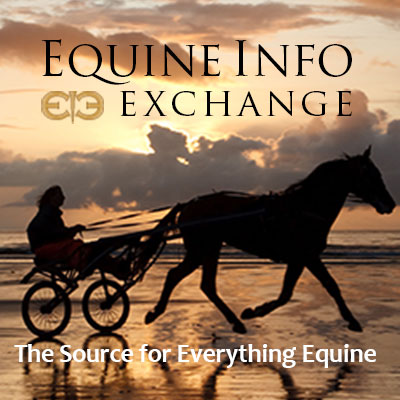Tack & Farm
Our Tack & Farm section features an Apparel section to find both practical and fashionable riding attire. If you ride English & Western or Race, many sources are available in the Tack section.
Building a barn? Need an architect for your equine dream home? Find one in Barns & Stalls.
Have a hungry horse? Of course you do! Find a place to buy your feed and tuck your horse in at night in the Bedding & Feed section. Looking for a place to keep your horse? You can find it in the Horse Boarding section. Keep your horse happy and beautiful with resources in our Grooming section.
Traveling? Find a Shipping company or Horse Sitting service if your horse is staying home!
Running and maintaining a farm or stable is a continuous effort, and to help find products or tools you need, please see our Equipment, Fencing and Management Tools sections.
Seeking Services? Find financial and tax expertise in our Accounting section. Companies who will help protect your investment are found in the Insurance section. For those who want legal advice about purchasing, liability, and other issues, please look at the Equine Law section to find an expert. Build and promote your business with teams from Marketing / Videography / Web Design.
Do we need to add more? Please use the useful feedback link and let us know!
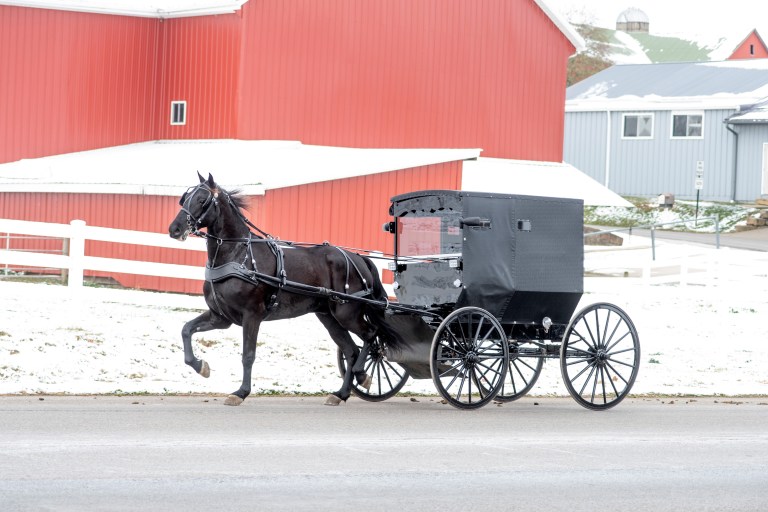
Bowman Harness is sustaining a living heritage tradition
By Lynn Ascrizzi
The folks at Bowman Harness, Ltd. of Millersburg, Ohio, don’t put much credence into talking big or taking on airs — they’re too busy doing. In fact, the four-generation, collective family enterprise has been hard at work making exceptional harness products and providing dedicated customer service for 100 years.
“We’re not here to put out a brag story. We try to do good quality at a fair price. Quality is what we care about,” said Joe Bowman Jr., 50. He co-owns the business with his older brother, John J. Bowman, 52. As the Bowmans see it, good work always speaks for itself.
The business is located in Holmes County, an area that hosts one of Ohio’s largest Amish communities — a close-knit culture of family, friends and neighbors, where horse-drawn vehicles and farm work done with draft horses are still the norm. It is here that those who work at Bowman Harness produce a solid, handsomely crafted and varied line of traditional harness and harness parts, suitable for all types of equine occasions.
“We make complete harness in leather and BioThane— a lot goes to the Amish and all over the country. We also wholesale harness parts for other shops. Less than half of our harness and harness parts business is wholesale. Ohio is one of our bigger areas for wholesale,” Joe said.
If you consider that only 3 percent of all family businesses are still operating after four generations, it’s pretty remarkable that, for 10 decades, the related hands and hearts at Bowman Harness have been able to pass down, intact, their special know-how. In doing so, this unique company has managed to sustain a living heritage craft tradition amid a fast-moving, high-tech world.
Yet, their harness tradition is not a static one. It embodies an expertise that has carefully evolved over time. For example, some harness designs have been modified, for better function, such as the recently introduced Wither Relief Saddle, made with a horse’s comfort in mind.
Read more: Celebrating 100 Years of Exceptional Harness Making
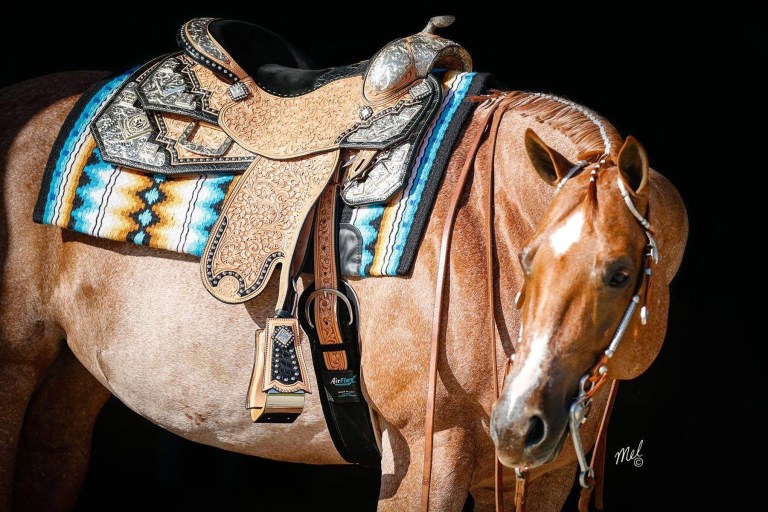
Harris Leather & Silverworks sets the standard for the show horse community
By Lynn Ascrizzi
Anyone deeply involved in big-time show horse events, such as The All-American Quarter Horse Congress,is well aware of the stature of Harris Leather & Silverworks and their hand-built, silver-spangled saddles and other artfully craftedleather tack.
“Our saddles and silverwork are what keep customers coming back and looking for that one-of-a-kind piece of show equipment,” said Phil Harris, who co-owns the business with his brother, Eddie Harris.
“I think our ability to customize and make products on a very high-quality level is unique,” Eddie added. “The customization is what separates our business from others — that, and the fact that we make everything under one roof.”
A gifted silversmith, Eddie directs the company’s silverworks shop. Phil, a highly accomplished saddle maker, heads up the leather workshop. Together, they share the duties of running the company, while maintaining their uniquely individual roles. “We both do what we need to, to get the job done,” Phil said.
Besides highly-decorative, custom products, the business also offers work saddles and other working equipment. But, the more ornate items are the company’s big draw. “Our customers are primarily the western show person who shows on a national level. We service associations related to the quarter horse, Arabians and like breeds,” he noted.
“The quarter horse show industry is primarily our bread and butter,” Eddie said. According to recent data from the American Horse Council, more than one million quarter horses are used specifically for showing purposes.
Their customers come from all walks of life and socio-economic status. Women make up two-thirds of sales. “The (show horse) market is primarily driven by women. They’re the ones who try the market,” Eddie said. “A horse and a girl are natural friends,” Phil added. “Their interests are definitely horses.”
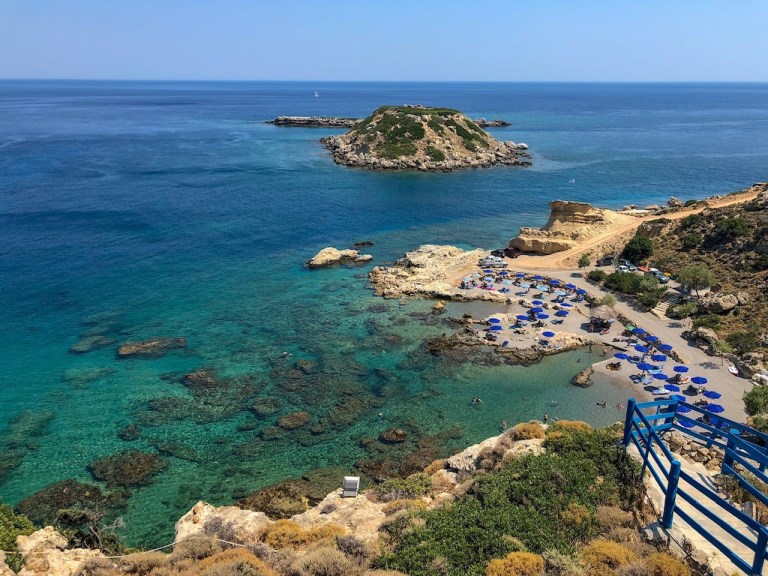
Co-founders of Epos Custom Leather create powerful mythic imagery and historical recreations
By Lynn Ascrizzi
If gray winter ever gets you down, think of the Greek island of Rhodes, set like a rough-cut gemstone in the sparkling Aegean.
“It’s called the ‘Island of the Sun,’” said Natalie Orfanidi, a gifted leather artist born and raised in Rhodes, the fourth largest island in Greece, a place where remains of ancient city walls, temples and other monuments resonate with the brilliant spirit of Greek antiquity. “The island has over 300 days of sunlight. Everywhere is near the water. It is quite hilly. There are a lot of mountains,” she said.
In 2015, Natalie and Michael Dale, an equally accomplished leatherworker, co-founded Epos Custom Leather in Rhodes.They live and work near Rhodes Town, a small village located on the northwestern tip of the island. Their snug workshop, set up in a 12-by-16-foot room on the second floor of their home, is only a 7-minute drive from the ever-present sea. “It’s pretty tiny,” Mike said, of their shared workplace. “Some of our projects spill out into the rest of the house.”
The couples’ finely-crafted, custom-made leather goods include passport cases, wallets, maps, holsters, guitar straps, purses, key fobs, archery arm guards and quivers. The highly-skilled, imaginative versatility of their leather carvings and special, historical recreations bring a distinctive vitality and character to their work.
“Epos (pronounced EH-pos) is a Greek word that means epic,” Natalie explained, a term that calls up legendary poems like the Odyssey, a classic tale about the harrowing journey of the Greek hero-king, Odysseus, who encounters fearsome sea monsters, giants, bewitching goddesses, ghost-spirits and plenty more, while he tries to sail home to Ithaca over the “wine-dark sea.”
Indeed, the captivating leather carvings created at Epos Custom Leather have their own epic dimension — artwork brimming over with powerful mythic archetypes from ancient Greece and other bygone cultures.
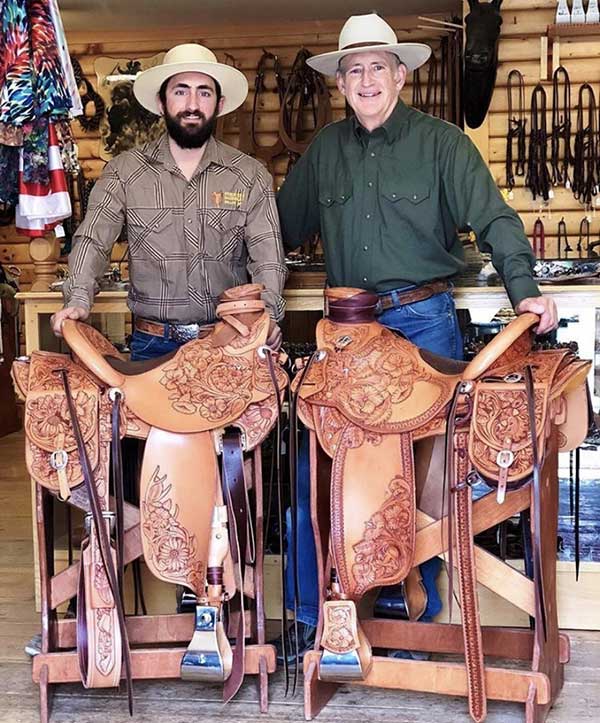
by Nick Pernokas
The tall cowboy eased through the crowd at the tradeshow. Every once in a while there was a flash of recognition from other shoppers, but then they went on about their business. This was Vegas after all. The National Finals Rodeo sported several large trade shows filled with western merchandise and it was easy to miss something if you didn’t pay attention. The cowboy was on a mission though, and he spied what he was looking for in the next vendor’s booth. He lowered his frame onto the beautiful tooled saddle. When the salesman came over to try to let the stirrups out, Tom Selleck shook his head and said, “No thanks, I’m looking for one for my wife.”
Selleck appreciated the quality of the saddle, and in a few minutes he’d ordered a custom Frecker saddle for his wife, Jillie.
Saddlemaker Kent Frecker developed a love of horses in childhood. His grandfather, a former rodeo cowboy, enjoyed hunting and packing on horseback. As Kent grew up, his grandfather instilled a love of these activities in him.
- J and M Custom Boots: A Legacy of Resiliency
- The Michelangelo of Cowboy Boots
- Horse Barn Modification for Miniatures, Mules and Donkeys
- 3 Companies That Excel at Outfitting Equestrians of All Sizes
- Horses Show Annual Grass Preferences
- Laughs and Lasts at Bell Custom Made Boots
- The Correct Way to Use Slow-Feeders
- Don Gonzales: Texas Saddlemaker, Leathercraft Teacher
- 4 Ideas for Advertising and Marketing Your Equestrian Center
- Why Outdoor Living is Better for Your Mare!






